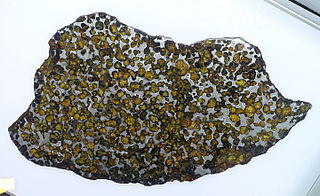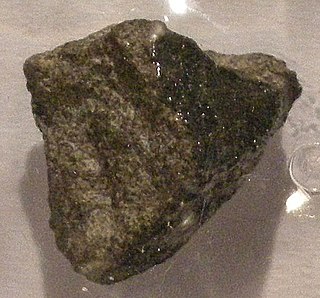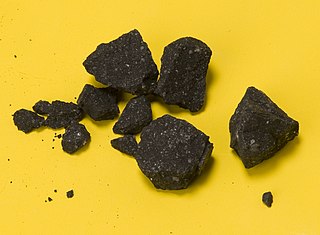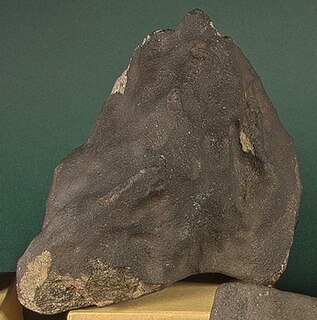 W
WThe term strewn field indicates the area where meteorites from a single fall are dispersed. It is also often used for the area containing tektites produced by large meteorite impact.
 W
WThe Allende meteorite is the largest carbonaceous chondrite ever found on Earth. The fireball was witnessed at 01:05 on February 8, 1969, falling over the Mexican state of Chihuahua. After breaking up in the atmosphere, an extensive search for pieces was conducted and over 2 tonnes (tons) of meteorite were recovered. The availability of large quantities of samples of the scientifically-important chondrite class has enabled numerous investigations by many scientists; it is often described as "the best-studied meteorite in history." The Allende meteorite has abundant, large calcium-aluminium-rich inclusions (CAI), which are among the oldest objects formed in the Solar System.
 W
WBrahin is a meteorite pallasite found in 1807. This is the second meteorite ever found in Russia. Sometimes it is also called Bragin or Bragim. It is quite common among collectors due to the affordable price of small partial slices.
 W
WBuzzard Coulee is the collective name of the meteorites fallen on November 20, 2008 over Saskatchewan, Canada.
 W
WCampo del Cielo refers to a group of iron meteorites and to the area in Argentina where they were found. The site straddles the provinces of Chaco and Santiago del Estero, 1,000 kilometers (620 mi) north-northwest of Buenos Aires, Argentina. It is half that distance, north-east, to Paraguay's capital, Asunción. The crater field covers 3 by 18.5 kilometres and contains at least 26 craters, the largest being 115 by 91 metres.
 W
WThe Canyon Diablo meteorites include the many fragments of the asteroid that created Barringer Crater, Arizona, United States. Meteorites have been found around the crater rim, and are named for nearby Canyon Diablo, which lies about three to four miles west of the crater.
 W
WThe Chelyabinsk meteorite is the fragmented remains of the large Chelyabinsk meteor of 15 February 2013 which reached the ground after the meteor's passage through the atmosphere. The descent of the meteor, visible as a brilliant superbolide in the morning sky, caused a series of shock waves that shattered windows, damaged approximately 7,200 buildings and left 1,500 people injured. The resulting fragments were scattered over a wide area.
 W
WChergach is a meteorite found at southwest of El Mokhtar, Erg Chech, Timbuktu district, Mali. It fell on 2 or 3 July 2007, in daytime, and was composed of ordinary chondrite (H5).
 W
WThe Cranbourne meteorite is an octahedrite iron meteorite. It is the second largest meteorite found in Australia after the Mundrabilla meteorite, but at the time of discovery it was the largest known iron meteorite in the world. It is classified as a main group IAB meteorite.
 W
WGebel Kamil is a meteorite that struck Egypt about 5000 years ago leaving a crater surrounded by thousands of pieces of iron shrapnel with a total weight of about 1,600 kilograms (3,500 lb).
 W
WGibeon is a meteorite that fell in prehistoric times in Namibia. It was named after the nearest town: Gibeon.
 W
WHomestead is a L5 meteorite fallen in 1875 in Iowa, United States.
 W
WImilac is a pallasite meteorite found in the Atacama Desert of Northern Chile in 1822.
 W
WThe Jbilet Wiselwan meteorite is a CM-type carbonaceous chondrite found in Western Sahara in 2013.
 W
WFifteen pieces of the Kainsaz meteorite were seen to fall near Kainsaz, Muslyumovo, Tatarstan in September 13, 1937. The largest weighed 102.5 kilograms (226 lb), the total weight was ~200 kilograms (440 lb). As of January 2013 pieces were on sale for ~US$100/g. Kainsaz is the only observed fall in Tatarstan.
 W
WL'Aigle is a L6 meteorite which fell on 26 April 1803 in Lower Normandy, France.
 W
WŁowicz is a stony-iron meteorite (mesosiderite) which fell on 12 March 1935 at 0:50 in the area of Krępa Rzeczyce and Wrzeczko villages, south of Łowicz. Numerous specimens were recovered.
 W
WMoss is a carbonaceous chondrite meteorite that fell over the communities of Rygge and Moss in Østfold county, southeast southern Norway in the morning of midsummer day, July 14, 2006.
 W
WThe Muonionalusta meteorite is a meteorite classified as fine octahedrite, type IVA (Of) which impacted in northern Scandinavia, west of the border between Sweden and Finland, about one million years BCE.
 W
WThe Nantan meteorite is an iron meteorite that belongs to the IAB group and the MG subgroup.
 W
WThe Novato meteorite is an ordinary chondrite which entered the earth's atmosphere and broke up over Northern California at 19:44 Pacific Time on 17 October 2012. The fireball created sonic booms and fragmented. The meteoroid was about 35 centimeters (14 in) across.
 W
WPark Forest is an L5 chondrite meteorite that fell on 26 March 2003 in Illinois, United States.
 W
WPeace River is a L6 chondrite meteorite fall on the morning of March 31, 1963.
 W
WPultusk is an H5 ordinary chondrite meteorite which fell on 30 January 1868 in Poland. The event has been known as the stony meteorite shower with the largest number of pieces yet recorded in history. Made up of rocky debris, it consists of pyroxene or olivine chondrules deployed in mass plagioclase, there being also kamacite.
 W
WThe Richardton meteorite is a 90 kilograms (200 lb) H5 Ordinary chondrite that was seen to fall at 21:48 on 30 June 1918 between Mott, North Dakota and Richardton, North Dakota, United States.
 W
WAn iron meteorite fell on the Sikhote-Alin Mountains, in southeastern Russia, in 1947. Large iron meteorite falls have been witnessed and fragments recovered but never before, in recorded history, a fall of this magnitude. An estimated 23 tonnes of fragments survived the fiery passage through the atmosphere and reached the Earth.
 W
WThe Springwater meteorite is a stony-iron pallasite, found near Springwater, Saskatchewan in 1931. At that time the find consisted of three large masses (38.6 kilograms, 18.6 kilograms and 10.6 kilograms. Other fragments have been found recently, including a 53 kilograms individual in 2009 that is now in the Royal Ontario Museum.
 W
WStannern meteorite fell on May 22, 1808 into the Moravian village Stonařov, in today's Czech Republic.
 W
WThe Sutter's Mill meteorite is a carbonaceous chondrite which entered the Earth's atmosphere and broke up at about 07:51 Pacific Time on April 22, 2012, with fragments landing in the United States. The name comes from the Sutter's Mill, a California Gold Rush site, near which some pieces were recovered. Meteor astronomer Peter Jenniskens assigned Sutter's Mill (SM) numbers to each meteorite, with the documented find location preserving information about where a given meteorite was located in the impacting meteoroid. As of May 2014, 79 fragments had been publicly documented with a find location. The largest (SM53) weighs 205 grams (7.2 oz), and the second largest (SM50) weighs 42 grams (1.5 oz).
 W
WThe Sylacauga meteorite fell on November 30, 1954, at 12:46 local time in Oak Grove, Alabama, near Sylacauga. It is commonly called the Hodges meteorite because a fragment of it struck Ann Elizabeth Fowler Hodges (1920–1972).
 W
WThe Tamdakht meteorite fell near Ouarzazate, Morocco on 2008-12-20 producing a strewn field of approximately 25 kilometres (16 mi) by 2 kilometres (1.2 mi) and two small impact craters, one of about 1.1 metres diameter and 70 centimetres (28 in) depth at 31°09.8′N 7°00.9′W and the other of about 20 centimetres (7.9 in) diameter and 10 centimetres (3.9 in) depth at 31°09.9′N 07°02.3′W.
 W
WŽemaitkiemis meteorite is an ordinary chondrite that fell near Žemaitkiemis, Lithuania at about 8:33 pm on 2 February 1933. Using the argon–argon dating method, scientists have calculated its age to be about 520 million years.